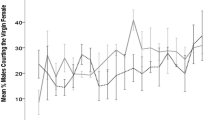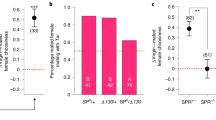Abstract
Flies carrying theinactive mutation ofDrosophila melanogaster have only 15% wildtype titers of the putative neurotransmitter octopamine. With a view to discovering whether theinactive mutation impairs learning, I describe the effect of theinactive mutation on experience-dependent courtship modification (EDCM). Wild-type males rapidly condition to immature males and modify their behaviour toward subsequent target flies. The weaker EDCM phenotype ofinactive males is similar to that ofdunce males. Using time-sampling, habituation is most rapid for wild-type males and slowest fordunce males, withinactive males showing an intermediate phenotype. These results support the notion that octopamine plays a significant role in the manifestation ofDrosophila learning behavior.
Similar content being viewed by others
References
Abrams, T. W., and Kandel, E. R. (1988). Is contiguity detection in classical conditioning a systems or cellular property? Learning inAplysia suggests a possible molecule site.Trends Neurosci. 11:128–135.
Arakawa, S., Gocayne, J. D., McCombie, W. R., Urquhart, D. A., Hall, L. M., Fraser, C. M., and Venter, J. C. (1990). Cloning, localisation, and permanent expression of aDrosophila octopamine receptor.Neuron. 4:343–354.
Ballinger, D. G., and Benzer, S. (1989). Targeted gene mutations inDrosophila.Proc. Natl. Acad. Sci. 86:9402–9406.
Bastock, M., and Manning, A. (1955). Courtship ofDrosophila melanogaster.Behavior 8:85–111.
Bicker, G., and Menzel, R. (1989). Chemical codes for the control of behavior in arthropods.Nature 337:33–39.
Collins, M. F., and Hewitt, J. K. (1984). The genetic architecture of the male courtship sequence inDrosophila melanogaster.Heredity 53:321–337.
Colllins, M. F., Hewitt, J. K., and Gogarty, J. F. (1985). Validating time sampled observations of courtship inDrosophila for behavior genetic analysis.Behav. Genet. 15:31–41.
David, J. C., and Coulon, J. F. (1985). Octopamine in invertebrates and vertebrates.Prog. Neurobiol. 24:141–185.
Davis, R. L. (1993). Mushroom bodies andDrosophila learning.Neuron 11:1–14.
Dudai, Y., Buxbaum, J., Corfas, G., and Ofarim, M. (1987). Formamidines interact withDrosophila octopamine receptors, alter the flies behavior and reduce their learning ability.J. Comp. Physiol. 161A:739–746.
Folkers, E., and Spatz, H. C. (1984). Visual learning performance ofDrosophila melanogaster is altered by neuropharmaca affecting phosphodiesterase activity and acetylcholine transmission.J. Insect. Physiol. 30:957–965.
Gailey, D. A., Jackson, F. R., and Siegel, R. W. (1982). Male courtship inDrosophila: The conditioned response to immature males and its genetic control.Genetics 102:771–782.
Gailey, D. A., Jackson, F. R., and Siegel, R. W. (1984). Conditioning mutations inDrosophila melanogaster affect an experience-dependent behavioral modification in courting males.Genetics 106:613–623.
Gailey, D. A., Hall, J. C., and Siegel, R. W. (1985). Reduced reproductive success for a conditioning mutant in experimental populations ofDrosophila melanogaster.Genetics 111:795–804.
Gailey, D. A., Villella, A., and Tully, T. (1991). Reassessment of the effect of biological rhythm mutations on learning inDrosophila.J. Comp. Physiol. 169A:685–697.
Goodhart, P. J., DeWolf, W. E., and Kruze, L. I. (1987). Mechanism-based inactivation of Dopamine β-hydroxylase byp-cresol and related alkylphenols.Biochemistry 26:2576–2583.
Hall, J. C. (1986). Learning and rhythms in courting, mutantDrosophila.Trends Neurosci. 9:414–418.
Jallon, J.-M., and Hotta, Y. (1979). Genetic and behavioral studies of female sex appeal inDrosophila.Behav. Genet. 9:257–275.
Kaplan, W. D. (1977).iav: inactive. Dros. Info. Serv. 52:1.
Kaiser, K., and Goodwin, S. F. (1989). “Site-selected” transposon mutagenesis ofDrosophila.Proc. Natl. Acad. Sci. 87:1686–1690.
Levin, L. R., Han, P.-L., Hwang, P. M., Fernstein, P. G., Davis, R. L., and Reed, R. R. (1992). TheDrosophila learning and memory generutabaga encodes a Ca2+/calmodulin-responsive adenylyl cyclase.Cell 68:479–489.
Manning, A. (1967). The control of female receptivity inDrosophila.Anim. Behav. 15:239–250.
O'Dell, K. M. C. (1993). The effect of theinactive mutation on longevity, sex, rhythm and resistance top-cresol inDrosophila melanogaster.Heredity 70:393–399.
O'Dell, K. M. C., Coulon, J. F., David, J. C., Fuzeau-Braesch, S., and Jallon, J.-M. (1987). La mutationinactive produit une diminution marquee d'octopamine dans le cerveau des Drosophiles.C. R. Acad. Sci. Paris Ser. III 305:199–202.
O'Dell, K. M. C., and Burnet, B. (1988). The effects on locomotor activity and reactivity of thehypoactive andinactive mutations ofDrosophila melanogaster.Heredity 61:373–381.
O'Dell, K. M. C., Burnet, B., and Jallon, J.-M. (1989). Effects of thehypoactive andinactive mutations on mating success inDrosophila melanogaster.Heredity 62:373–381.
Saudou, F., Amlaiky, N., Plassat, J.-L., Borrelli, E., and Hen, R. (1990). Cloning and characterization of aDrosophila tyramine receptor.EMBO J. 9:3611–3617.
Siegel, R. W., and Hall, J. C. (1979). Conditioned responses in courtship behavior of normal and mutantDrosophila.Proc. Natl. Acad. Sci. 76:3430–3434.
Tompkins, L. (1989). Homosexual courtship inDrosophila. In Carew, T. J., and Kelley, D. B. (eds.),Perspectives in Neural Systems and Behavior, Alan R. Liss, New Work, pp. 229–248.
Tompkins, L., Hall, J. C., and Hall, L. M. (1980). Courtshipstimulating volatile compounds from normal and mutantDrosophila.J. Insect. Physiol. 26:689–697.
Tully, T. P., and Quinn, W. G. (1985). Classical conditioning and retention in normal and mutantDrosophila.J. Comp. Physiol. 157A:263–277.
Uzzan, A., and Dudai, Y. (1982). Aminergic receptors inDrosophila melanogaster: Responsiveness of adenylate cyclase to putative neurotransmitters.J. Neurochem. 38:1542–1550.
Author information
Authors and Affiliations
Rights and permissions
About this article
Cite this article
O'Dell, K.M.C. Theinactive mutation leads to abnormal experience-dependent courtship modification in maleDrosophila melanogaster . Behav Genet 24, 381–388 (1994). https://doi.org/10.1007/BF01067539
Received:
Accepted:
Issue Date:
DOI: https://doi.org/10.1007/BF01067539




